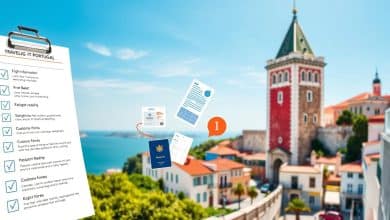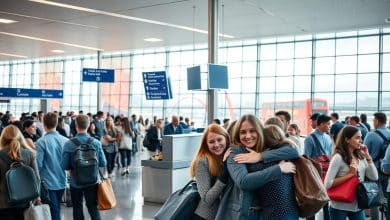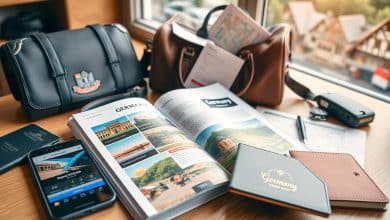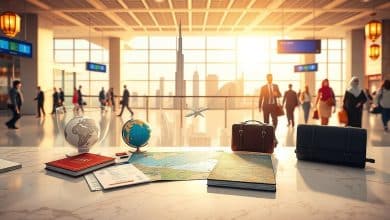Italy Travel Tips: Key Benefits and Advantages You Need to Know Before You Go
Anúncios
Italy’s charm lies in its timeless blend of art, history, and culinary traditions.
Visitors often find themselves captivated by ancient ruins, flavorful dishes, and warm local interactions. Yet first-time explorers sometimes face unexpected hurdles when cultural norms or service expectations differ from their assumptions.
Preparation transforms these potential challenges into opportunities for connection. Learning basic phrases like “buongiorno” or understanding regional dining customs helps travelers avoid tourist traps. Small efforts to respect local etiquette often lead to richer experiences and smoother interactions.
This guide focuses on practical insights for navigating the country’s diverse regions. From mastering train schedules to discovering hidden trattorias, proper planning ensures every moment counts. Those who embrace these strategies frequently report deeper cultural immersion and better value during their stay.
Many return home already dreaming of their next Italian adventure. With the right approach, even minor missteps become memorable stories rather than frustrations. The key lies in balancing spontaneity with thoughtful preparation.
Understanding the Essence of Travel Tips Italy
Exploring this Mediterranean country reveals a tapestry of distinct regional cultures. From Sicilian street markets to Alpine villages, each area operates like its own microcosm. Understanding these differences transforms a standard vacation into a journey of discovery.
Aligning Your Expectations
Italy’s rhythm differs from fast-paced destinations. Service often prioritizes personal connections over speed—meals stretch for hours, and shopkeepers might chat before ringing up purchases. Researching regional customs provides valuable information. For example, Neapolitans embrace spontaneity, while Milanese life moves with businesslike efficiency.
Cultural Immersion and Local Vibes
True connection happens beyond major landmarks. Attend a sagra (food festival) in Umbria or watch artisans craft Murano glass. Family-run trattorias reveal culinary secrets passed through generations. As one Roman chef notes: “Our recipes aren’t written—they’re breathed in from childhood.”
Visitors who embrace slow-paced lunches and afternoon strolls often find deeper joy. This approach unlocks hidden piazzas and casual conversations that shape unforgettable trip memories.
Planning Your Itinerary for an Authentic Trip
A well-crafted itinerary bridges iconic sights and unexpected discoveries. Prioritizing depth over quantity creates space for serendipity while maintaining structure. This balance lets visitors absorb local rhythms without feeling rushed.
Balancing Major Cities and Hidden Gems
Base yourself in hubs like Rome or Florence to access both metropolitan attractions and nearby towns. Day trips to places like Siena or Padua reduce packing stress while offering cultural variety. Mid-sized cities like Bologna deliver vibrant markets and medieval architecture with fewer tourist crowds.
Limiting overnight stays to 2-3 cities preserves energy. As one frequent traveler notes: “Four hours lost relocating could mean missing a sunset over the Tuscan hills.” Pair mornings exploring famous landmarks with afternoons wandering lesser-known neighborhoods.
Scheduling and Flexibility Tips
Spring and autumn visits avoid summer’s heat and congestion. Leave blank slots in daily plans for spontaneous wine tastings or extended café conversations. Train tickets between cities often cost less when booked 2-3 months ahead.
Allocate extra time for meals and transit delays—Italian schedules favor enjoyment over punctuality. This approach turns potential frustrations into opportunities to connect with locals. A relaxed pace reveals hidden courtyards and family-run shops that rigid agendas might overlook.
Navigating Italian Transportation Options
Efficient movement between destinations enhances every journey. The country’s rail system stands out as a backbone for intercity connections, blending speed with scenic views. Smart planning helps visitors maximize their hours exploring rather than navigating logistics.
Train Strategies and Booking Tips
High-speed services like Frecciarossa and Italo zip between Rome, Florence, and Milan at up to 186 mph. Booking these tickets 10-12 weeks early often cuts costs by half compared to last-minute purchases. “I reached Venice from Naples in under five hours—with wine and WiFi the whole way,” shares frequent rider Giulia Marchetti.
Regional trains offer a different pace, perfect for day trips to towns like Orvieto or Lucca. No reservations mean spontaneous stops at vineyards or medieval villages. Stations sit in city centers, eliminating lengthy airport transfers.
Public Transit and Alternative Methods
Urban buses and trams require validated tickets—stamp them at yellow machines before boarding to avoid €50 fines. Metro systems in Rome and Milan simplify cross-town travel during peak times.
For shorter distances, bike rentals or walking often prove faster than taxis in historic districts. Many locals recommend the #italiarail hashtag for real-time service updates. This approach balances cost efficiency with authentic cultural immersion.
Mastering Italian Cultural Customs
Cultural norms shape daily interactions here, acting as silent guides to deeper connections. Visitors who grasp these unspoken rules often find smoother transitions from observer to participant.
Local Etiquette and Greetings
A simple “buongiorno” (good morning) or “buonasera” (good evening) opens doors. Locals value these greetings more than hurried transactions. One Roman waiter shares: “Foreigners who try our words—even clumsily—become guests, not customers.”
Understanding Service Standards
Meals unfold like conversations here—leisurely and layered. What some call “slow service” reflects a philosophy where dining isn’t just eating. Staff prioritize creating ambiance over rapid turnover.
Tipping follows different rules. Leaving €0.20 for espresso or rounding up restaurant bills shows appreciation without excess. As Florentine chef Marco Rossi explains: “We remember the smile more than the coins.”
Building rapport matters. A question about regional wines or a compliment on pasta sauce often yields insider recommendations. This approach transforms routine service into cultural exchange.
Savoring Italy: Food and Beverage Insights
Flavors here tell stories of generations, with every bite and sip revealing local pride. From sun-drenched vineyards to bustling espresso bars, culinary traditions shape daily rhythms. Embracing these customs unlocks deeper connections with both people and places.
Authentic Cuisine Discoveries
Regional differences define the food landscape. Tuscan ribollita stew showcases humble ingredients, while Sicilian caponata bursts with Mediterranean brightness. “Our recipes mirror the land’s heartbeat,” explains Bologna chef Elena Moretti. Always pair dishes with local wines—Barolo enhances Piedmont’s rich meats, while Vermentino complements Ligurian seafood.
Skip restaurants near landmarks. Family-run trattorias tucked into side streets offer better value and quality. House wines often come from nearby vineyards, chosen to harmonize with the menu. For example, order tagliatelle with ragù in Emilia-Romagna—never spaghetti.
Coffee Culture Dos and Don’ts
Mornings begin with sweet cornetti and frothy cappuccino at standing-room-only bars. After 11 AM, switch to espresso—ordering milky coffee later draws polite confusion. Locals often drink their quick shot at the counter, paying less than seated service.
Regional preferences influence coffee styles too. Neapolitans favor strong, sugary brews, while Turin’s bicerin mixes espresso with chocolate. Remember: un caffè means espresso. Asking for a “latte” gets you plain milk—order a caffè latte instead.
Understanding Italian Dining Etiquette
Dining in this European nation follows a rhythm rooted in tradition—a dance between culinary artistry and social connection. Meals unfold as cherished rituals rather than rushed transactions. Recognizing these patterns helps visitors avoid common missteps while deepening their cultural experience.
Meal Times and Restaurant Customs
Lunch typically runs from 12:30 to 14:00, with many restaurants closing by 14:30 for afternoon rest. Evening service rarely starts before 19:30, peaking around 20:30 as families gather. Locals view meals as social events: “Dinner isn’t just eating—it’s sharing stories,” notes Venice restaurateur Luca Bianchi.
Most establishments require requesting the bill (il conto). Servers won’t bring it automatically, respecting guests’ lingering time. Afternoon closures between 14:00-19:00 mean planning snacks or café visits. Those arriving early for dinner often find locked doors until official opening hours.
Tipping Practices and the “Coperto” Charge
The coperto (cover charge) appears on every bill, covering bread, table settings, and service—usually €1-3 per person. This isn’t a tip but a standard fee. For appreciation, rounding up €5-10 on a €50 meal suffices. Waitstaff earn livable wages, making excessive tipping unnecessary.
Menus often highlight regional specialties. Trust servers’ wine pairings—they know which local red complements Tuscan steak best. As Florentine chef Sofia Russo advises: “Let the food’s origin guide your choices.” By embracing these customs, diners transform meals into cultural exchanges rather than mere transactions.
Travel Tips Italy: Coping with Crowded Tourist Spots
Popular destinations face unprecedented visitor numbers, with iconic sites like Rome’s Colosseum and Florence’s Uffizi Gallery seeing record crowds. Locals note summer months bring waves of travelers, turning narrow streets into slow-moving streams of people. Savvy explorers adapt by combining careful timing with tech tools.
Strategies for Peak Tourist Seasons
Early risers gain quiet moments at Trevi Fountain or Venice’s Rialto Bridge before 8 AM. Evening strolls after 10 PM reveal illuminated piazzas with space to breathe. “We’ve never seen so many visitors in July,” shares Roman guide Sofia Ricci. Pre-booked tickets skip long queues at major museums—reserve Vatican entry slots weeks ahead.
Key approaches include:
- Booking early-access tours for attractions like Milan’s Duomo
- Exploring historic centers during lunch hours when crowds thin
- Using city passes with timed entry to multiple sites
Peak season (April-October) demands flexibility. Midday heat often drives visitors indoors, creating opportunities for shaded café breaks. While some areas feel overwhelmed, adjusting schedules transforms crowded trips into rich cultural exchanges.
Effective Day Trip Planning From Major Cities
Smart explorers know that strategic base cities unlock diverse experiences without constant relocation. Staying in central hubs allows immersive exploration of surrounding regions while avoiding packing fatigue. The secret lies in choosing destinations accessible within 60-90 minutes by train—maximizing discovery time while minimizing transit hours.
Ideal Day Trip Destinations Around Italy
Florence serves as a gateway to Tuscan gems like Lucca’s intact Renaissance walls and Siena’s medieval streets. A local guide advises: “Skip Pisa’s crowded tower—Lucca offers bike rides along ancient ramparts and quieter piazzas.” Bologna connects travelers to Verona’s Roman arena and Ravenna’s Byzantine mosaics, plus lesser-known towns with legendary food scenes.
From Rome, Tivoli’s villa gardens and Sperlonga’s coastal charm make rewarding escapes. Venice provides access to Padua’s Giotto frescoes and Valdobbiadene’s prosecco vineyards. These options balance iconic sights with authentic local flavors.
Maximizing Your Stay at a Central Hub
Choose accommodations near major train stations for efficient morning departures. Milan-based traveler Gina Ferraro shares: “I explored Lake Como and Bergamo’s Venetian walls without ever repacking my suitcase.” Limit overnight stays to 2-3 cities—each hub can fuel 3-4 day trips before moving on.
Avoid marathon journeys like Rome-to-Pompeii day trips. Instead, focus on nearby places that reveal regional character. This approach preserves energy for leisurely dinners and spontaneous discoveries, turning every return to your base city into a welcome homecoming.
Tips for Minimizing Luggage Hassles and Airport Logistics
Historic areas often lack elevators or smooth pathways, requiring visitors to maneuver suitcases over uneven cobblestones and station staircases. Thoughtful preparation prevents these challenges from overshadowing the adventure. A strategic approach to luggage management ensures energy stays focused on cultural discoveries rather than logistical headaches.
Mastering Dawn Departures
For flights departing around 7 AM, pre-book rides through apps like FreeNow or hotel concierge services. Public transport rarely operates this early, and last-minute taxis prove unreliable. One frequent traveler notes: “Saving that 5 AM panic search makes the airport espresso taste better.”
Essentials-First Packing Approach
Choose neutral-colored, wrinkle-resistant clothing that mixes easily—ideal for cobblestone treks and evening aperitivos. Limit shoes to two versatile pairs, prioritizing comfort over style. A lightweight, refillable water bottle stays handy for fountain refills while reducing plastic waste.
Roll garments instead of folding to maximize space in one checked bag and a compact backpack. This combo simplifies navigating crowded trains and tight hotel stairwells. Remember: overpacking often leads to more decisions, not better ones. Leave room for local finds like ceramics or leather goods.
For more information, see the official travel site:
You will be redirected to another website
FAQ
How can visitors balance popular cities with lesser-known areas?
Prioritize iconic destinations like Rome or Venice but allocate time for regions like Umbria or Puglia. Smaller towns often provide quieter, authentic experiences without heavy crowds.
What’s the best way to navigate Italy’s train system?
Book high-speed trains (Frecciarossa, Italo) in advance for discounts. Regional trains work for shorter routes but may require purchasing tickets at stations. Validate tickets before boarding to avoid fines.
Are there specific greetings or customs to follow?
A handshake or light cheek kiss (among friends) is common. Use “buongiorno” (good day) or “buonasera” (good evening) when entering shops. Dress modestly in churches.
What should travelers know about coffee culture?
Order espresso as “un caffè” and drink it quickly at the bar. Cappuccino is a morning-only choice. Avoid ordering lattes, as they’re not traditional.
How does tipping work in restaurants?
A service charge (“coperto”) is often included. Round up the bill or leave 5-10% extra for exceptional service. Tipping isn’t mandatory but appreciated.
What strategies help avoid crowds at major attractions?
Arrive early (before 8 AM) or book skip-the-line tickets. Visit landmarks like the Colosseum or Vatican Museums during weekdays or shoulder seasons.
Which day trips are recommended from central hubs?
From Florence, explore Chianti vineyards or Siena. Milan offers access to Lake Como, while Naples serves as a gateway to Pompeii and the Amalfi Coast.
How can packing be optimized for convenience?
Use carry-on luggage for short stays. Bring versatile layers and comfortable shoes. Pack a reusable water bottle to refill at public fountains.
What are common mistakes to avoid with meal times?
Restaurants often close between lunch and dinner (3–7 PM). Plan meals around local schedules—lunch around 1 PM and dinner after 8 PM in most regions.
Why is regional cuisine important to explore?
Dishes vary widely: try Roman carbonara, Sicilian arancini, or Venetian cicchetti. Avoid tourist-trap menus; seek trattorias with daily specials written in Italian.
Published on: 24 de July de 2025

Sofia Kamara
Sofia Kamara is the founder of GoldenCred.blog, a platform built to guide students and young professionals in navigating international opportunities. With a background in public policy and international relations, Sofia has spent years helping people secure scholarships, sponsorship visas, and financial planning strategies for studying abroad.
She believes that accessible, accurate information is a powerful tool for change. Her writing combines practical advice with strategic insights, crafted especially for those eager to take bold steps toward education and career development in countries around the world.







